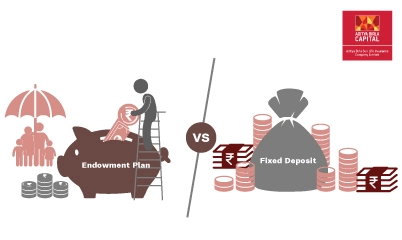1. Stock Market
• Definition: A stock market is a place for buyers and sellers of ‘stock’ - part ownership in
a company- meet. The stock market facilitates the exchange of securities between buyers and sellers.
• Features and benefits: The stock market offers the potential to generate an odd amount of
returns since stocks are highly volatile investments. One can find value stocks or growth stocks to invest in based
on their preference, both of which have historically been great market performers in the long run.
• Return rate: The average rate of return of NSE India is 17%.
• Eligibility: To invest in stocks, you need to be over 18 years of age with an active Demat
and trading account that you can open through a broker.
• Risk level: Stocks are a moderate to high-risk investment vehicle, so it is important to
learn as much about investing in the stock market, do research, have an informed opinion, and be clear about your
investment goals and tenure before you opt into them.
• Example: As an example of how investments in the stock market work, let’s assume you buy a
share worth ₹10 and the next day, the share price increases to ₹15. This way, within 24 hours, you can realise a
profit of 50% on your investment.
• How to invest: To invest in the stock market, open a demat and trading account with a
reputable broker or through your bank account if feasible. Next, visit the trading platform of BSE or NSE through
your brokerage, and pick stocks you are interested in. Determine your investible corpus, tenure, and appreciation
goals and begin investing.
2. Mutual fund
• Definition: A mutual fund is an investment in a basket of securities that works by pooling
investors' funds and investing them across different stocks, bonds, and other assets.
• Features and benefits: Diversity is an instant benefit for investors when they invest in a mutual
fund. Each fund will have multiple assets, meaning its performance will likely not be as volatile as investing in an
individual stock. They are actively or passively managed by a fund manager, which takes away the responsibility on
behalf of the investor to track their fund actively. You can also invest as a SIP or a lump sum offering more
flexibility.
• Return rate: The average rate of return of mutual funds can range from 9% (debt funds) to 21%
(equity funds), with the latter being more volatile.
• Eligibility: To invest in mutual funds, you need to be over 18 years of age. You need not have an
active Demat and trading account.
• Risk level: Mutual funds are moderate-risk investment vehicles linked to the market. Equity funds
carry a higher risk than steady debt funds, but you can get the best of both in a balanced fund.
• Example: Mutual funds work as follows. Let’s say that you invest in a mutual fund with a SIP of
₹5000 a month. Within a year, you have invested ₹60,000, and the fund has offered you returns worth ₹10,000,
building your investment corpus to ₹70,000. This is why it is recommended to stay invested in funds for longer
periods to make the most of compounding.
• How to invest: To invest in a mutual fund, check if your broker offers this service. You will
need an active bank account to link to your investment if you plan on investing via a SIP. Determine your investible
corpus, tenure, and appreciation goals and begin investing.
3. IPO
• Definition: An IPO stands for initial public offering. It is when a company chooses to offer its
stock to the public for the first time to raise additional capital right before it begins trading on the stock
market.
• Features and benefits: IPOs are a great way to get in on a value stock early. In the best-case
scenario, the price at which one bought the IPO stock is lower compared to the trading stock price, meaning one can
sell their IPO shares at a profit. Although this is not guaranteed1, IPOs give investors this
opportunity.
• Return rate: The average rate of return of IPOs is highly variable. Based on the company chosen,
it can be anywhere from something as low as 4% to as high as 89% or even more. There is no fixed range as
such.
• Eligibility: To invest in an IPO, you need to be over 18 years of age. You will need to have an
active Demat and trading account. You will also need to qualify based on whether you can invest the minimum
investment amount.
• Risk level: IPOs tend to be higher-risk investments. There is no guarantee that a company will
perform better in the market than its expected share price in its IPO. However, when IPOs do outperform in the
market, the returns are highly profitable.
• Example: Consider the IPO for Delhivery. Its IPO price was ₹487. When the IPO launched, the stock
traded at ₹537, which is a 10.22% increase.
• How to invest: To invest in an IPO, check if your broker offers this option. You will need an
active demat and trading account to buy IPO shares. Determine your investible corpus based on the minimum investment
amount, tenure, and appreciation goals and begin investing.
4. SIP
• Definition: A SIP stands for a systematic investment plan. It is a way of investing in an
instrument in regular intervals rather than at once as a lump sum amount.
• Features and benefits: SIPs are a great way for investors to start building a corpus without too
much disposable income. With a monthly investment SIP of as low as ₹500 in (let’s assume) a mutual fund, by the end
of the year, the investor will have invested ₹6,000.
• Return rate: The average rate of SIPs depends on the instrument invested in. If one is using SIPs
for mutual funds, the rate of return averages between 9% (debt funds) to 21% (equity funds), with the latter being
more volatile.
• Eligibility: To invest in mutual funds using a SIP, you need to be over 18 years of age. You will
need a regular income to ensure your SIP is paid on time. You can invest in mutual funds SIPs without a Demat and
trading account.
• Risk level: SIPs can be moderate to higher-risk investments based on the mutual fund selected.
Equity funds are considered higher risk than debt funds but also offer scope for better returns in the long
run.
• Example: A SIP of ₹1000 for five years will result in an investment corpus of ₹60,000, and at a
return rate of 15% (from an equity mutual fund), it will yield a return of ₹9000.
• How to invest: To invest using SIP, check with your mutual fund's platform if this option is
available to you. Carefully select a fund you plan to remain invested in in the long run, Be clear about investment
amount, goals, tenure, and risk before investing.
5. Real Estate
• Definition: Real estate is an investment in property. You can invest in real estate without
actually owning the physical property or by becoming a landlord.
• Features and benefits: Real estate is considered a great tool to diversify a portfolio. Most
property prices tend to appreciate in value, so real estate can also be a profitable investment in the long run.
• Return rate: Real estate has had a return rate of 11.6% per year in the past year.
• Eligibility: To invest in real estate, you might need to be of a certain age and have a certain
annual income, but this varies based on the location of the property you are considering. Becoming a landlord also
requires certain eligibility criteria that can vary from state to state.
• Risk level: Real estate comes with different kinds of financial risk making it moderately risky.
As an investment vehicle, it can be high risk as the market is unpredictable and location matters.
• Example: An example of property appreciation can be checking the value of your own home. If it is
appreciated, your family (if you own your home) real estate investment has been profitable.
• How to invest: To invest in real estate, find real estate investment groups online, look at
rental properties, and seek out online real estate platforms. You will learn of the eligibility criteria at each of
these sites.
6. Gold ETF
• Definition: Gold ETFs are exchange-traded funds that invest in gold, a valuable addition to a
financial portfolio without physically owning gold.
• Features and benefits: Gold ETF take out the risks associated with the physical ownership of gold
as an investment. Gold can erode over time, depreciating its value, but since ETFs are electronic holdings, the
value of gold is preserved. These are also a great vehicle to diversify a portfolio as gold tends to do well during
market recession periods while stocks and other investments drop.
• Return rate: In the past year, gold ETFs have given a rate of return of 23.64% per year.
• Eligibility: To invest in a gold ETF, you might need to be at least 18 years old and have an
active mutual funds account. You can also buy gold ETFs on the stock market, where you will need a Demat and trading
account to facilitate your investment.
• Risk level: Gold ETFs are relatively low-risk investments, even if one trades them on the stock
market.
• Example: Similar to mutual funds, let's say one invested in a gold ETF SIP for five years at a
rate of ₹1000 a year. With a return of (assuming) 20%, the cumulative corpus will be ₹72,000 in five years.
• How to invest: To invest in gold ETFs, open a demat and trading account with your broker or go
via your mutual fund's platform.
7. RBI Bonds
• Definition: RBI bonds are a relatively secure savings investment, also known as government bonds.
• Features and benefits: These are stable investments in bonds that offer the benefit of savings at
an interest rate that is better than a typical bank account. You can be assured of minimal volatility when you
invest in RBI bonds.
• Return rate: RBI bonds have given a return rate of 7.15% in the past year.
• Eligibility: To invest in RBI bonds, you need to be an Indian citizen, as NRIs are not eligible
to invest in them as of yet. You can also be from a Hindu Undivided Family.
• Risk level: RBI bonds are low-risk, stable savings investments.
• Example: Let’s assume you invest a corpus of 1 lakh in RBI bonds. On Jan 1st, you will earn ₹3575
and the same amount on July 1st, totalling your returns to ₹7150.
• How to invest: To invest in RBI bonds, Visit any of the designated RBI branches by SEBI, visit
any of the 4 private sector banks in India, or visit the Stock Holding Corporation of India.
8. ULIPs
• Definition: ULIPs stand for unit-linked insurance plans. You get to invest in mutual funds while
getting the benefit of life insurance with ULIPs.
• Features and benefits: These investments offer market returns and life insurance safety in a
single investment. You can also get tax benefits2 on an investment corpus in ULIPs worth ₹1.5 lakhs as per Section
80C of the Income Tax Act. Note that ULIPs come with a five-year lock-in period.
• Return rate: In the past year, ULIPs have given a return rate of 10% to 12% per year.
• Eligibility: To invest in ULIPs, you need to be able to qualify for the term plan offered as well
as be able to invest in market instruments.
• Risk level: Although they have a savings component, ULIPs are moderate risk instruments as they
invest in market funds.
• Example: The ABSLI Wealth Aspire Plan is a great ULIP example. An investor planning to grow their
wealth via ULIPs can invest in equity funds where their investment premiums are invested in higher-risk funds that
offer better returns. Simultaneously they will have an active life insurance policy.
• How to invest: To invest in ULIPs, check for any active plans offered by your bank or financial
institution. Compare plans by assessing the lock-in period, additional costs, and terms and conditions before
investing.
9. Direct Equity
• Definition: Direct equity implies those investments made in the stock of companies directly. IPOs
and stock market investments are a form of direct equity investments.
• Features and benefits: These investments offer the benefit of boosted market returns at a higher
risk than other investments. They can be traded within 24 hours, or held over the long term.
• Return rate: In the past year, direct equity has given a return rate of 11% in India year over
year.
• Eligibility: To invest in direct equity, you need to have a demat and trading account with a
broker and access to the Indian and global stock markets.
• Risk level: Direct equity is a high-risk instrument, offering the potential for extremely good
returns.
• Example: An investor can invest in direct equity by buying stocks directly from the stock market.
If the value of the stock appreciates over time, the investor can sell their stock at a profit.
• How to invest: To invest in direct equity, open a demat and trading account with a reputable
broker or through your bank account if feasible. Next, visit the trading platform of BSE or NSE or any other stock
market through your brokerage, and pick stocks you are interested in. Determine your investible corpus, tenure, and
appreciation goals and begin investing.
10. ELSS
• Definition: ELSS stands for equity-linked savings schemes that invest in equity funds with a
minimum lock-in period of 3 years and offer tax benefits2 under Section 80C.
• Features and benefits: These investments offer returns from equity investments thanks to their
lock-in period but are not as high risk as investing in direct equity. Additionally, one can also reap
tax-deductibility of ₹1.5 lakhs invested each year in ELSS.
• Return rate: In the past year, ELSS has offered a rate of return of 8.5%.
• Eligibility: To invest in ELSS, check if your mutual funds' providers offer these schemes. You
will not need to open a demat and trading account, but you will need an active mutual fund account.
• Risk level: ELSS are moderate risk instruments, but they can offer great returns when investing
in higher-risk funds.
• Example: An investor can invest in ELSS for five years at ₹50,000 a year. With a return of
(assuming) 20%, the cumulative corpus will be ₹3 lakhs in five years.
• How to invest: To invest in ELSS schemes, browse the schemes available on your mutual funds'
provider’s platform. Carefully read the terms and conditions, compare fund performance, and determine your
investment tenure, goals, and risk appetite.
11. FIxed maturity plans
• Definition: Fixed maturity plans are mutual funds with fixed returns investing in debt
instruments that mature at the time that aligns with the tenure of the scheme.
• Features and benefits: Fixed maturity plans offer safe returns without much volatility compared
to investing in equity mutual funds. They make for a great savings tool since you get better interest rates than
with standard savings accounts.
• Return rate: In the past year, fixed maturity plans have offered a rate of return of 8% year over
year.
• Eligibility: To invest in fixed maturity plans, you need to be 18 years and above. Check if your
mutual funds' providers offer these schemes. You will not need to open a demat and trading account, but you will
need an active mutual fund account.
• Risk level: Fixed maturity plans have a relatively low-risk level. Since they have guaranteed1
maturity but are market-linked, you can expect some fluctuation in your investments, but they are not as volatile as
equity funds.
• Example: Aditya Birla Sun Life Fixed Term Plan - Series SC. An investment of ₹1 lakh for a five
year lock-in period in a fixed maturity plan at a 10% return will yield a corpus of ₹5.5 lakhs at maturity.
• How to invest: To invest in fixed maturity schemes, browse the schemes available on your mutual
funds' provider’s platform. Carefully read the terms and conditions, compare fund performance, and determine your
investment tenure, goals, and risk appetite.
12. Treasury bills
• Definition: Treasury bills are money market instruments issued by the Indian government and
presently issued as short-debt instruments in three tenors: 91 days, 182 days, and 364 days.
• Features and benefits: Treasury bills are a great way to increase one’s savings investments as
these bills are non-market instruments. Note that treasury bills are zero coupon instruments that pay no interest.
• Return rate: The rate of return on treasury bills is fixed throughout the tenure of the bond.
Three-month bills have a return of 1.15%, and 1-year bills have upto 2% returns.
• Eligibility: To invest in treasury bills, a minimum bid amount of 25,000 and multiple of the same
is necessary. Companies, individual firms, insurance companies, trusts, provided funds, and more are eligible to
invest in treasury bills.
• Risk level: Treasury bills are low-risk instruments with guaranteed1 returns.
• Example: A ₹100 treasury bill can be availed of at ₹95, although the buyer pays ₹100 at the
maturity date.
• How to invest: To invest in treasury bills, you can use your savings bank account or a UPI
interface.




 Table of Contents
Table of Contents
 Home Loans
Home Loans
 Personal
Loans
Personal
Loans
 SME Loans
SME Loans
 Business Loans - Udyog
Plus
Business Loans - Udyog
Plus
 Loan against Securities
Loan against Securities
 Mutual Funds
Mutual Funds
 Stock and
Securities
Stock and
Securities
 Portfolio
Management Services
Portfolio
Management Services
 Pension Funds
Pension Funds
 Life
Insurance
Life
Insurance
 Health
Insurance
Health
Insurance
 Wellness
Solutions
Wellness
Solutions
 Pay Bills
Pay Bills
 Pay anyone
Pay anyone
 Pay on call
Pay on call
 Payment
Lounge
Payment
Lounge
 ABC Credit
Cards
ABC Credit
Cards

 1800-270-7000
1800-270-7000









